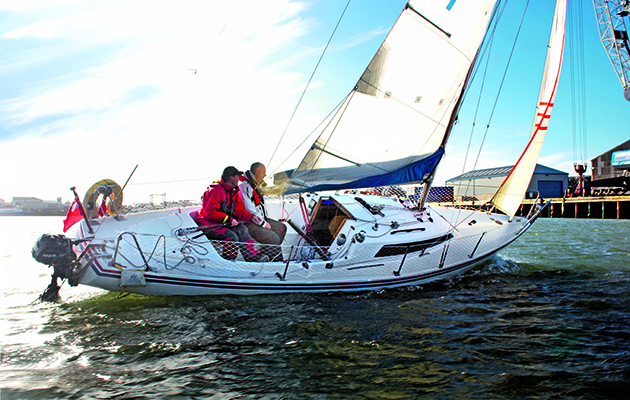Seasoned skippers and Yachting Monthly experts give their advice on a whole range of issues for the cruising sailor
Insulation solution

Wood plastic strips make a tough finish over the foam insulation for a toasty cabin. Credit: Brian Black
Like most modern boats, mine manages to keep the water where it belongs — on the outside.
So I was puzzled over the course of the winter that there was a damp feeling, especially in the forecabin despite running a passive heater during the colder months to keep the air dry and prevent condensation gathering on the inside of the forehatch.
By coincidence, I had been planning to line the hull with some sort of insulation prior to an Arctic cruise this season and as work progressed the damp atmosphere seemed to disappear.
I removed the side linings of the forecabin and lined the hull with 1in (25mm) thick Kingspan foam insulation.
This proved simple enough, strips cut and bonded to the hull with a silicone adhesive before replacing the linings.
The next stage was to do something similar in the lockers to port and starboard beneath the bunks, a fiddly job as it required working upside down.
I didn’t like the aluminium foil finish on the foam; it was too glaring and in any case would tear easily if anything hard brushed against it.
The problem was easily solved.

Brian Black has survived nine Arctic seaons since the mid-1990s and often finds himself getting out of tricky situations at sea
I went to my local home supplies supermarket and bought a couple of packs of adhesive 6in (15cm) wide simulated wood plastic strips, cut them to shape and bonded them in place.
The result looks good and is a definite improvement.
The cabin is now snug even without any additional heat and the condensation seems to have gone.
I checked all this with a yacht surveyor I know and he foresaw no downside, suggesting that yoga mat material or something similar might be easier to work, possibly applying it in double layers.
My next step is to install a solar-powered extractor vent in the overhead hatch to encourage the circulation of air.
All in all, the result is a more comfortable cabin at minimum outlay.
Brian Black
Lobster pot defence

Profile showing position of string on fin and skeg
The menace of badly marked pots and their securing lines is getting worse.
I would have liked a rope cutter attached to the propshaft as a defensive measure but an already stretched budget could not afford the cost. So an alternative!
My boat has a generous fin and skeg mounted rudder with the propeller emerging from the hull in-between.
I set about linking fin and skeg with a piece of old rigging wire tensioned with a bottle screw, which in the event of running over a pot line might just prevent it snagging the prop.

Nylon string should fail before causing damage. Credit: Brian Black
My first attempt was to swage an eye to either end of the wire and attach it to a fitting on the keel and the bottle screw on the skeg.
An alarm bell was ringing — what if we should ground on a rock or perhaps be craned out sometime and the lifting strop settle on the wire?
There was a chance that the whole thing could come under immense pressure and possibly damage the skeg, a disaster caused by what I had thought of as a good idea.
So to plan ‘B’. I replaced the bottle screw with a length of nylon cord, strong enough to withstand a pot line but weak enough to break when under potentially damaging pressure.
A word of caution. I haven’t yet fouled a pot line or gone aground on this boat so what I have done is still in the theoretical category. But it should work.
Brian Black
Continues below…
Skippers’ Tips: Clever waypoints & rigging fatigue
Seasoned skippers and Yachting Monthly experts give their advice on a whole range of issues for the cruising sailor
Skippers’ Tips: Flush the outboard & check your halyards
Seasoned skippers and Yachting Monthly experts give their advice on a whole range of issues for the cruising sailor
Skippers’ Tips: DIY tidal plotter & heed chart warnings
Seasoned skippers and Yachting Monthly experts give their advice on a whole range of issues for the cruising sailor
Mooring the ‘wrong side’

Allowing your boat to rest on the leeward side of the lock is safer and easier. Credit: Alamy
I quite often see people mooring on the windward side of a lock.
The obvious problem here is that if you are not able to attach your lines, you will drift to the leeward side of the lock and crash into it.
In the Netherlands we have many locks and I have passed through hundreds of them in the past 30 years — many singlehanded in both a Pioneer 10 and a long keel 36ft Koopmans.

Harry Deckers is an RYA Yachtmaster Offshore and has sailed around the UK singlehanded
Unless there isn’t the space to do so, I always intend to moor to the leeward side of the lock.
It is true that if your speed is too high, there is a chance you will damage your hull, but you can control your speed.
The biggest advantage, however, is that if for some reason you fail to attach your mooring line to the lock wall, you will at least be ‘steady’ against it (and yes, you will need two or more fenders to protect the hull).
In all the lock transits I have made it has never gone wrong.
Another suggestion I have is to moor primarily on a stern line running from your headsail sheet winch.
You can do this with all wind directions but a brief word of warning: you should fully stop the yacht with your engine, as winches are not built to deal with the shock-loading likely to be experienced.
The winch will easily hold the yacht once stopped.
Doing this ensures the mooring line is ‘pointing’ towards the turning point of the yacht, which offers better static control.
If you use the stern mooring cleat you might not be able to do so unless the yacht has a very wide stern.
Harry Dekkers







